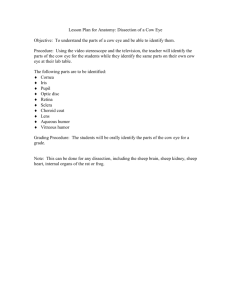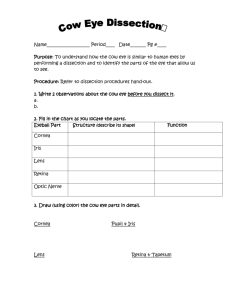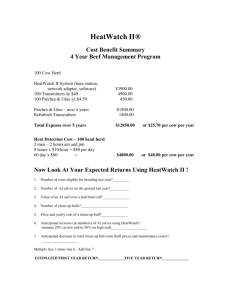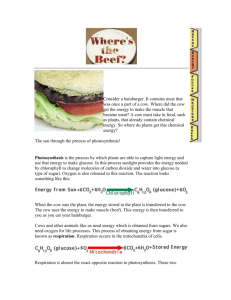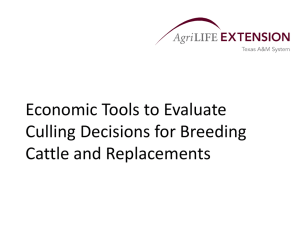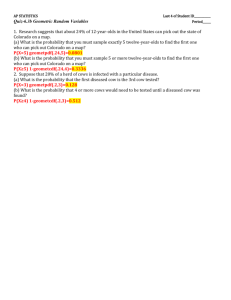Economic Tools to Evaluate Culling Decisions for Breeding Cattle and Replacements
advertisement
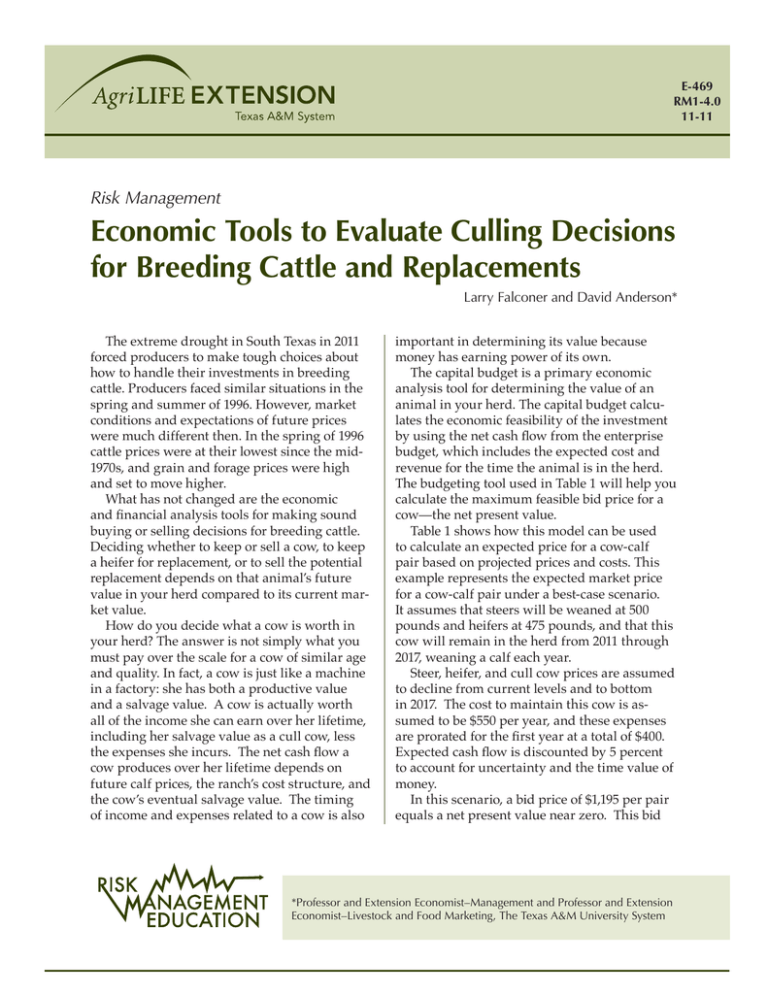
E-469 RM1-4.0 11-11 Risk Management Economic Tools to Evaluate Culling Decisions for Breeding Cattle and Replacements Larry Falconer and David Anderson* The extreme drought in South Texas in 2011 forced producers to make tough choices about how to handle their investments in breeding cattle. Producers faced similar situations in the spring and summer of 1996. However, market conditions and expectations of future prices were much different then. In the spring of 1996 cattle prices were at their lowest since the mid1970s, and grain and forage prices were high and set to move higher. What has not changed are the economic and financial analysis tools for making sound buying or selling decisions for breeding cattle. Deciding whether to keep or sell a cow, to keep a heifer for replacement, or to sell the potential replacement depends on that animal’s future value in your herd compared to its current market value. How do you decide what a cow is worth in your herd? The answer is not simply what you must pay over the scale for a cow of similar age and quality. In fact, a cow is just like a machine in a factory: she has both a productive value and a salvage value. A cow is actually worth all of the income she can earn over her lifetime, including her salvage value as a cull cow, less the expenses she incurs. The net cash flow a cow produces over her lifetime depends on future calf prices, the ranch’s cost structure, and the cow’s eventual salvage value. The timing of income and expenses related to a cow is also important in determining its value because money has earning power of its own. The capital budget is a primary economic analysis tool for determining the value of an animal in your herd. The capital budget calculates the economic feasibility of the investment by using the net cash flow from the enterprise budget, which includes the expected cost and revenue for the time the animal is in the herd. The budgeting tool used in Table 1 will help you calculate the maximum feasible bid price for a cow—the net present value. Table 1 shows how this model can be used to calculate an expected price for a cow-calf pair based on projected prices and costs. This example represents the expected market price for a cow-calf pair under a best-case scenario. It assumes that steers will be weaned at 500 pounds and heifers at 475 pounds, and that this cow will remain in the herd from 2011 through 2017, weaning a calf each year. Steer, heifer, and cull cow prices are assumed to decline from current levels and to bottom in 2017. The cost to maintain this cow is assumed to be $550 per year, and these expenses are prorated for the first year at a total of $400. Expected cash flow is discounted by 5 percent to account for uncertainty and the time value of money. In this scenario, a bid price of $1,195 per pair equals a net present value near zero. This bid *Professor and Extension Economist–Management and Professor and Extension Economist–Livestock and Food Marketing, The Texas A&M University System value leads to an internal rate of return of 5 percent during the 7 year period. These results indicate that a bid of $1,195 per pair would be the maximum feasible bid price in this example. At any price above $1,195, the producer would be better off selling the pair. If drought increases the maintenance cost in the first year, it would be even more advantageous to sell the cow-calf pair at any price above $1,195. In early May 2011, young to middle-aged cow- calf pairs with 100 to 300 pound calves were selling in South Texas for $900 to almost $1,100 per pair. The high end of this range is slightly below the maximum feasible bid price of $1,195. Under normal circumstances, the producer would be better off keeping the pair at those sub-$1,100 prices. However, current drought conditions make it likely that the prorated operating cost for 2011 is too low. In our example, there is only $95 per pair in cur- Table 1. Cow bid price estimate calculator example. Steer weight 500 Cull cow sale weight (lb/head) Heifer weight 475 Number of calving opportunities (yr) $1,195 Discount rate (%) Pair price 1,000 Lb. 7 Net present value (NPV) 5.00 % ($0.09) 2011 2012 2013 2014 2015 2016 2017 Year 1 Year 2 Year 3 Year 4 Year 5 Year 6 Year 7 100 100 100 100 100 100 100 Steers price ($/cwt) $140 $150 $155 $133 $130 $126 $126 Heifer price ($/cwt) $134 $144 $149 $127 $124 $120 $120 $0 $0 $0 $0 $0 $0 $60 Gross receipts (calf sales) $668 $717 $741 $634 $620 $600 $600 Cow operating cost/year $400 $550 $550 $550 $550 $550 $550 Net above operating cost $268 $167 $191 $84 $70 $50 $50 $0 $268 $167 $191 $84 $70 $50 $50 $0 $0 $0 $0 $0 $0 $0 $600 $0 Year Calf crop or weaning % Cull cow price ($/cwt) $0 Financing information Net Cash Flow Cow Salvage Value Pre-tax cash flows Year 0 Year 1 Year 2 Year 3 Year 4 Year 5 Year 6 Year 7 ($1,195) $268 $167 $191 $84 $70 $50 $650 *Comments regarding this investment scenario. The analysis of this scenario is on a pre-tax basis. The negative net present value indicates that the price of $1,195 per head is too high. This investment has an internal rate of return of 5.0%. This investment has a payback period of 7 years. The positive cash flows across the planning horizon indicate that this investment is financially feasible. 2 $0 rent value to cover any additional costs due to the drought. If $95 would not cover extra expenses, it would be better to sell the pair now. Also, if the cow missed weaning a calf in any subsequent year, the model would generate a sell signal. This example shows how a cattle producer can use an economic model to evaluate alternatives when faced with selling decisions in response to drought. For tools like the one in Table 1 to yield accurate data on which to base decisions, producers must use data that is specific to their operation. Producers should manipulate production, cost and output price assumptions to see how those changes would affect the decision variables. The expected value of different types of cows in your herd depends on factors that are uncertain. Because of the uncertainty, many people consider this type of planning a waste of effort. The future seldom unfolds exactly as planned, and expecting current conditions to prevail is unreasonable. The planning process, however, need not yield an exact prediction to be valuable. There is no method that will consistently provide the best culling strategy. Given the differences in age composition of herds and the physical resources for a particular ranch, the “cull half” and “cull to pay feed” may not be enough for a younger herd or may be too much for an older herd. However, the capital budget tool can help you calculate what might be best for your situation. The “right” answer depends on the cost structure for your ranch and what you expect future prices to be. These tools are available through your local county Extension office or at http://agecoext.tamu.edu/ resources/software.html Partial funding support has been provided by the Texas Corn Producers, Texas Farm Bureau, and Cotton Inc.–Texas State Support Committee. Produced by Texas A&M AgriLife Communications Extension publications can be found on the Web at AgriLifeBookstore.org Visit the Texas AgriLife Extension Service at AgriLifeExtension.tamu.edu Educational programs of the Texas AgriLife Extension Service are open to all people without regard to race, color, sex, disability, religion, age, or national origin. Issued in furtherance of Cooperative Extension Work in Agriculture and Home Economics, Acts of Congress of May 8, 1914, as amended, and June 30, 1914, in cooperation with the United States Department of Agriculture. Edward G. Smith, Director, Texas AgriLife Extension Service, The Texas A&M System. Revision

